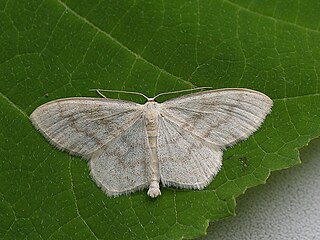
The cream wave is a moth of the family Geometridae. The species was first described by Adrian Hardy Haworth in 1809. It is found in forest and woodland regions, feeding on grasses and small plants such as dandelion.
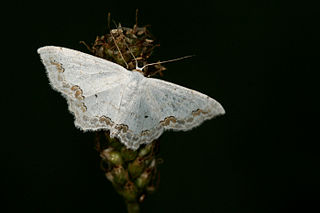
Scopula ornata, the lace border, is a moth of the family Geometridae. The species was first described by Giovanni Antonio Scopoli in his 1763 Entomologia Carniolica. It is found in Europe, North Africa and the Near East.

Scopula limboundata, the large lace-border, is a moth of the family Geometridae. It was described by Adrian Hardy Haworth in 1809. It is found in North America east of the Rocky Mountains. There is a single and unconfirmed record from Great Britain.

Scopula frigidaria is a moth of the family Geometridae. It was described by Heinrich Benno Möschler in 1869. It is found from Fennoscandia to the Kamchatka Peninsula and in northern North America, where it occurs across the boreal forest region, from Alaska across the Northwest Territories and Nunavut to Newfoundland, and in the mountains south to southern Wisconsin, Alberta and British Columbia.

Scopula incanata is a species of moth in the family Geometridae. It is found from north-eastern Europe and the Caucasus to southern Siberia and northern Mongolia.
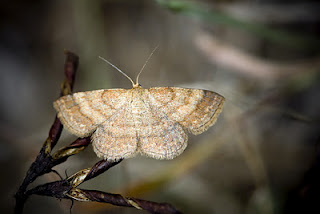
Scopula turbidaria is a species of moth in the family Geometridae. It is found in France, Spain and Portugal. It is also found in North Africa.

Scopula emutaria, the rosy wave, is a species of moth in the family Geometridae. It is found in western and south-western Europe and Romania. Also in North Africa.
Scopula annularia is a moth of the family Geometridae first described by Charles Swinhoe in 1890. It is found from the north-eastern Himalayas to Hong Kong, Myanmar, Sumatra, Borneo, Java, the Philippines, Sulawesi and Seram.
Scopula asellaria is a moth of the family Geometridae. It was described by Gottlieb August Wilhelm Herrich-Schäffer in 1847. It is found in southern Europe and North Africa.

Scopula subpunctaria is a species of moth in the family Geometridae. It is found from northern and north-eastern China to the southern Palearctic realm.
Scopula prouti is a moth of the family Geometridae. It is found from north-eastern China to Korea, Japan and south-eastern Russia.
Scopula indicataria is a moth of the family Geometridae. It is found in China, Korea, Japan and Russia.

Scopula beckeraria is a moth of the family Geometridae. It was described by Julius Lederer in 1853. It is found in Italy, Croatia, North Macedonia, Greece, Bulgaria, Romania, Ukraine, Russia, Turkey, Armenia, Israel, Lebanon, Iran, Turkmenistan and Kazakhstan.
Scopula confinaria is a moth of the family Geometridae. It is found in southern Europe, southern Russia and Turkey.
Scopula hyphenophora is a moth of the family Geometridae. It is found in India, Peninsular Malaysia and on Borneo and Bali. The habitat consists of lowland primary and secondary forests, alluvial forests and forests on limestone.

Scopula submutata, the Mediterranean lace border, is a moth of the family Geometridae. It is found in southern Europe, North Africa and the Near East. The habitat consists of open, dry grassland and rocky slopes.
Scopula pratana is a moth of the family Geometridae. It is found in North Africa, the Canary Islands, the Near East and Yemen.
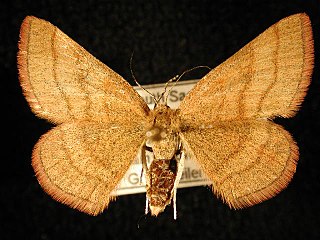
Scopula sentinaria is a moth of the family Geometridae. It is found from Alaska to Labrador, south in the prairies to southern Manitoba, Saskatchewan, Alberta and British Columbia. In the mountains it ranges south to Colorado. The species is also found in northern Russia and the Sayan Mountains. The habitat consists of dry shrubby clearings and edges.
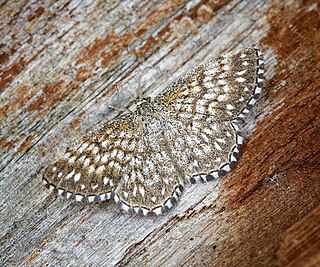
Scopula tessellaria, the dusky-brown wave, is a moth of the family Geometridae. It is found in Belgium, Luxembourg, France, Germany, Italy, Spain, Albania, former Yugoslavia, Croatia, Bulgaria, Romania, North Macedonia, Greece, Moldova, Ukraine and Russia. In the east, the range extends to the Near East and the eastern part of the Palaearctic realm.
Scopula sideraria is a moth of the family Geometridae. It is found in western North America, from southern British Columbia to San Diego County, California.












